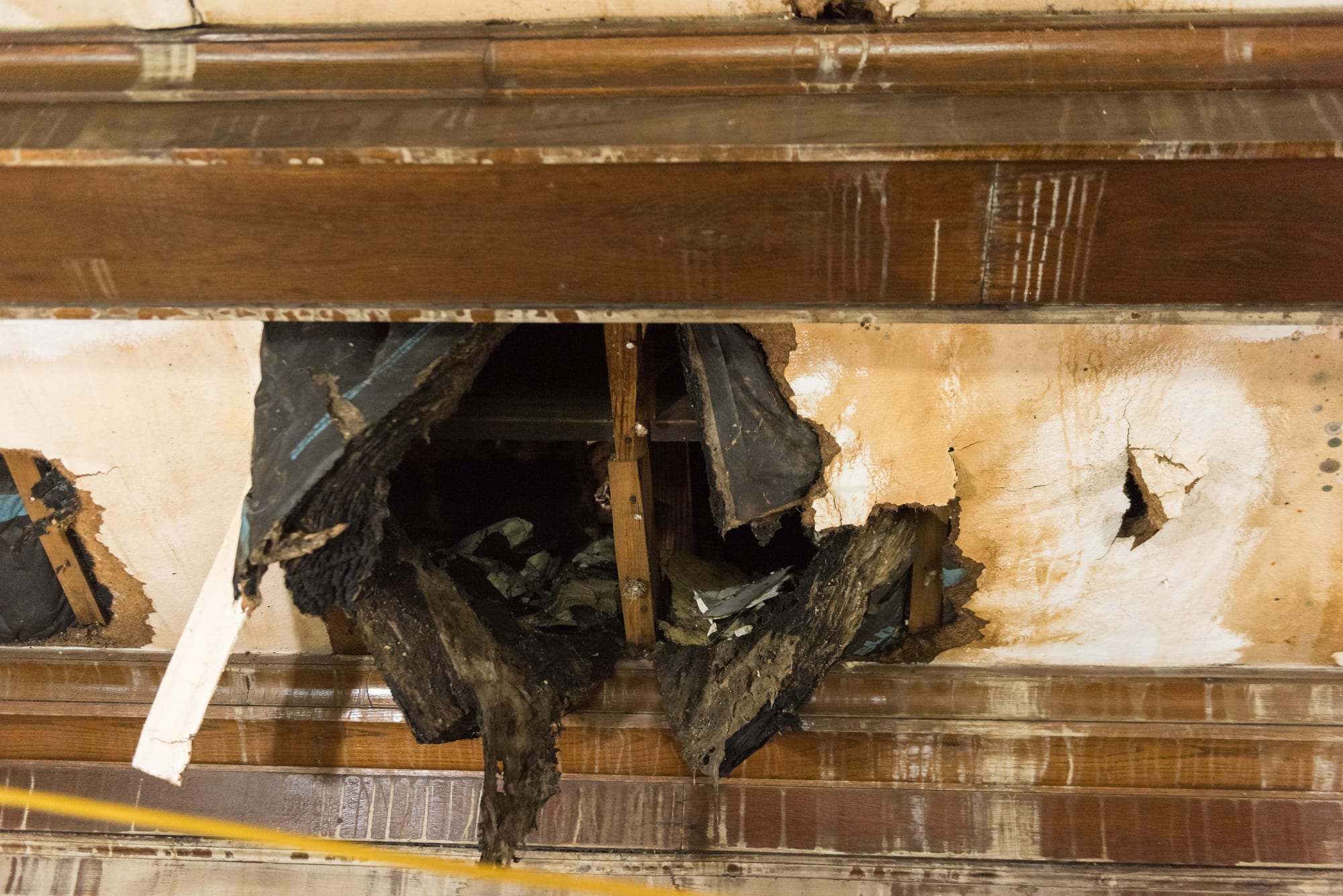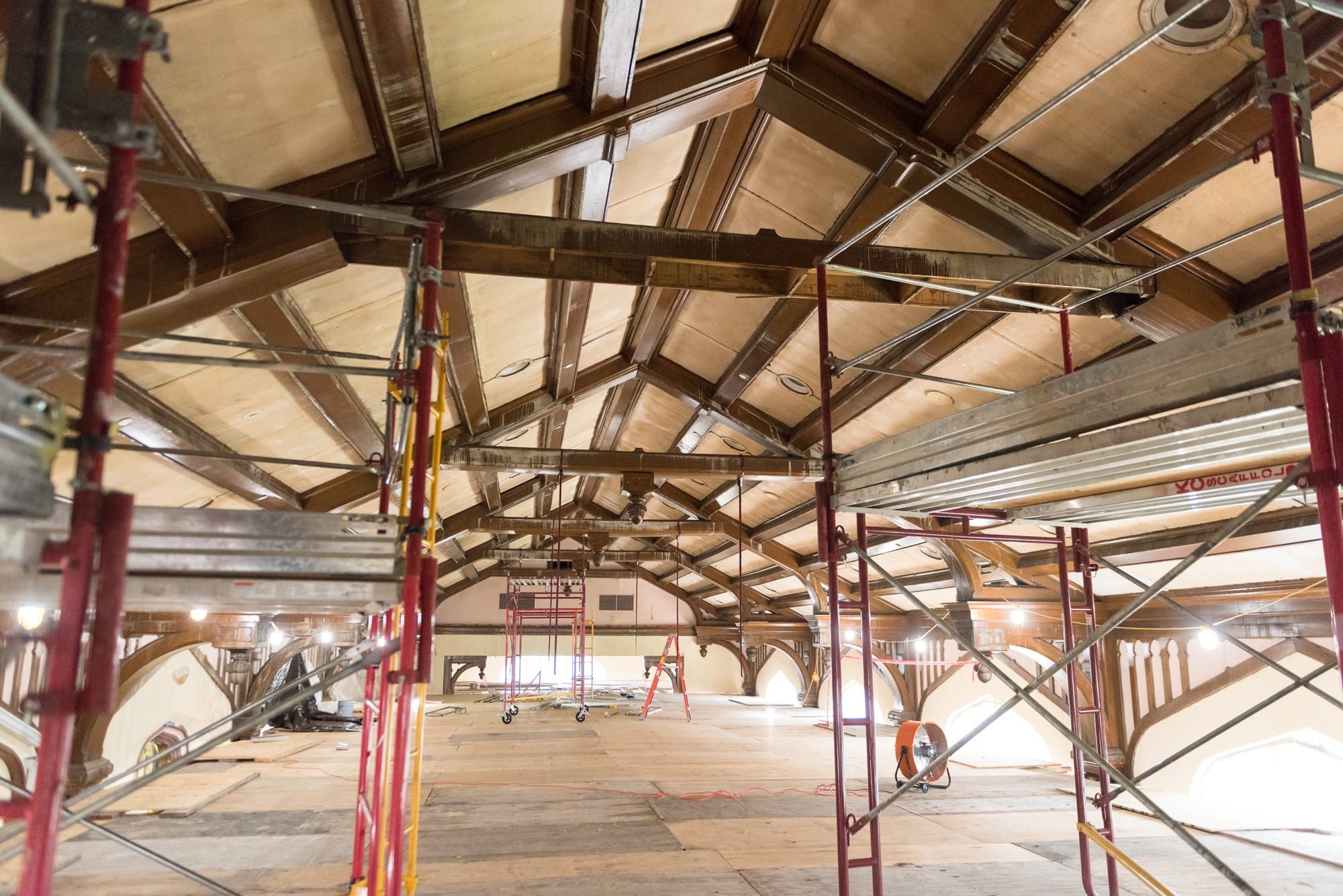Perhaps the most-frequently asked question we’ve received since the fire is “Will the Great Room be okay?”
The answer is a complicated yes.

Historic Farrell Library, the original 1927 library building, sustained significant damage, and it has been a long and difficult process to determine the next steps for preserving the structure.
The fire started in the roof just south of the Great Room, and it spread quickly, so it was difficult to isolate and extinguish. Because the room was at the center of the firefighting efforts, it took on a significant amount of water from both the firefighting and the sprinkler system. Since the building materials in Farrell—plaster, limestone, wood—are all highly porous, they absorbed a lot of water.
TreanorHL, an architecture firm with strengths in historic preservation, and John Canning Studios, a conservation/preservation studio, have subcontracted with Belfor Property Restoration, our emergency recovery team. The two organizations are assessing the damage and executing the subsequent recovery processes to aid in returning the space to its original state.

Connecticut-based John Canning Studios has worked across the country on projects such as the White House and the US Treasury Building. In Topeka, they installed plaster beams and capitals in the Kansas Statehouse that were part of the original plans but never executed. They also completed extensive plaster repairs in 100 spaces throughout the capitol.
On July 20, Darchelle Martin, public information officer, spoke with Dave Gough, John Canning Studios’ historic preservation manager.

Gough, who has been with Canning for more than 10 years, arrived in Manhattan on July 5 to assess the damage. Since then, their top priority has been drying the space, but the process must happen slowly in order to prevent additional damage.
Currently, they’re working on removal of architectural paint. Gough said that paint acts as a barrier that keeps moisture from evaporating, so eliminating the paint from the walls, columns, and capitals (the ornamental plaster at the top of the columns), will help the walls dry more quickly.
He also explained that a lot of plaster delamination has occurred throughout the space: The top, protective layers of plaster were compromised by the water, and the exposed surface is much more porous, which increases the ability of the wall to breathe and dry. The loss, while unfortunate, is repairable.
“Right now we are in defensive mode, especially regarding the murals,” Gough said. “We’re trying to stop any more damage from occurring.”

Once the drying process is further along, the focus will shift to preserving the space and restoring it as much as possible to its original state. The paint colors, the light fixtures and all other components of the room will be examined in historic photos and analyzed through scientific methods, too, so they can determine what it looked like in its very earliest days. The option to restore the room to a more historically accurate appearance is being explored.
“We will take paint samples from the painted surfaces and make an analysis under a microscope,” Gough said. “We will find out what the original historic colors were, in order to learn what the original architect’s design intent was. There’s a lot of science involved in what we do.”

Plaster and paint are just two of the materials that will be preserved. The team has a complex system in place to make sure all of the oak woodwork in the room is restored.
“We’re removing all the wood in pieces,” Gough said. “We catalog it, we’ll clean the backside of it and get rid of any biological growth, such as mold and mildew. Then we’re going to strip the front of it, preserve it. Finally, the wood will all be stored until the rest of the space has been repaired and it can be refinished and reinstalled.”
Gough said that the bookshelves and bookcases in the room are all oak, too, but they’ve determined that not all of the material is original to the room. Only the portions that are original will be salvaged and receive the same treatment as the oak beams and other ornate woodwork.
Hale Library Great Room – 07/20/2018 – Spherical Image – RICOH THETA
“It’s going to be a time intensive job,” Gough said. “There is a lot involved in keeping it organized and keeping the pieces together. It’s a process of reverse engineering, taking it apart piece by piece, preserving it, and making sure it all goes back together in the same place. It’s going to be quite a feat.”
The timeline is equally complicated.
“We don’t know yet when it can go back up,” he said. “It depends on a lot of circumstances, like how dry the building is and how quickly the roof and ceiling can be rebuilt. They’ll also put in a fireproof ceiling and venting. Once all that construction is done, we’ll hope to be back on site and start reinstallation.”

In our next post, we’ll tackle another big question: “What will happen to the Great Room murals?”